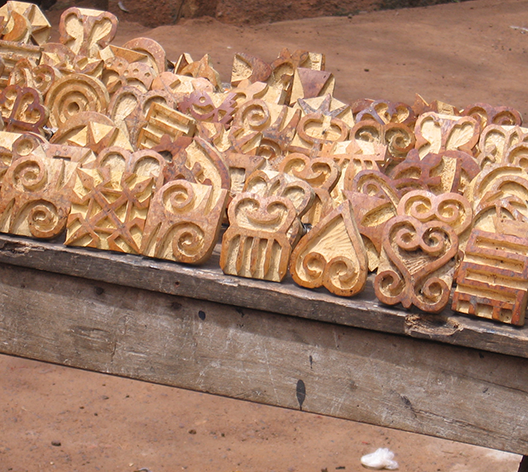
The Adinkra Sankofa bird symbol attracted my attention repeatedly as I traveled throughout Ghana in 2008. Of the more than 100 Adinkra symbols, this one seemed to hold an important message for me. From the time I stepped off of the plane and onto the tarmac in Accra, Ghana, I felt a spiritual essence communicating with me in a sensory, nonverbal way. It felt like an ancestor or ancestors with important messages to share, and that communication continued throughout the trip.
After my attention was drawn to the Sankofa bird symbol so many times, I asked what it meant. Our guide explained that the Adinkra symbols, originating from the Akan people of Ghana, are important cultural and spiritual symbols and that the Sankofa symbol means “Go back and fetch it.” The symbols are seen all over Ghana on fabrics, wood carvings, buildings, paintings, and more. They are also meaningful and popular throughout the African diaspora.
The Sankofa symbol, a bird with an egg in its beak flying forward but looking backwards, is often associated with the Akan proverb, “Se wo were fi na wosankofa a yenkyi,” which translates as: “It is not taboo to go back for that which you have forgotten.” After inquiring a bit more, a fuller meaning emerged: go back and retrieve from the past what is important to bring into the present and future.
I spent a lot of time during and after the trip discerning the meaning and message for me in that particular Adinkra symbol. In time I discovered that the communication was about my purpose – my task. Things I was to remember, retrieve, or reclaim from the past and bring into the present and future. As the meaning and its purpose for my life unfolded, several themes emerged:
- Remember, reclaim, and share the stories and wisdom of my African-American ancestors with current and future descendants,
- Learn the wisdom and healing traditions of my African ancestors and those of other indigenous people around the world, and incorporate that wisdom respectfully in my healing offerings,
- Honor the relationship my family has had with plants for generations, and bring that forward for current and future generations. Honoring the ways in which plants bring beauty, healing, and nutrition into our lives, and learning to grow food, even in small spaces.
- Honor the legacy of a female ancestral spirit guide, a healer who I sense used medicinal plants to care for her village.
Each of these themes has informed and guided my learning and work since.
While paying due honor and respect to the creators of the Adinkra symbols in Ghana, I wanted a representation of the Sankofa bird to inspire a return to indigenous plant wisdom. The Sankofa bird represents African ancestry and the message communicated to me during my travels in Ghana. The green leaves as part of the tail feathers represent the ancestral and current day healing power of plants grown in natural, healthy soils. Plants for nutrition and healing, for preparing the space in energy healing work, and as powerful teachers and metaphors for our individual and collective growth and wellbeing. The leaves in the tail feathers also signify for me how we collaborate with plants and with other humans to co-create change in health, families, and communities.
There are two especially significant experiences in Ghana that feel related to this symbolic representation of Sankofa:
- My visit to the village of Ntonso, north of Kumasi, where the Adinkra tradition of the Akan people has been preserved for generations, and
- My visit to the Centre for Scientific Research into Plant Medicine in Mampong-Akwapim where indigenous plant medicine is being preserved.

In Ntonso, I witnessed Asante craftsmen make the black dye from the bark of the Badie tree and apply it to fabric using stamps of Adinkra symbols carved into calabash gourds. In that village, traditional Adinkra stamps are still made by hand and used in the creation of the stamped cloth they are known for. Originally the stamped cloth (red, brown, and black) was worn for funerals in the Ashanti region, but today it is made in many colors and is used throughout Ghana and around the world. Both the Badie tree and the calabash have many uses. The bark of the Badie tree was used in West African herbal medicine to treat malaria and other fever-related illnesses. The hard shells of mature calabashes are what makes them particularly useful for household and cultural purposes in Ghana.
Another very special place was the Centre for Scientific Research into Plant Medicine, renamed the Centre for Plant Medicine Research in 2011. The work of the Centre is to gather and preserve the rich ancestral knowledge of medicinal plants from villages throughout Ghana. In addition to cataloging the plants and healing modalities, the Centre reproduces and scales that wisdom to provide herbal remedies for local clients. As a former pharmaceutical scientist and lifelong lover of plants, I felt so at home in that place that was preserving traditional knowledge of plants used in healing and reproducing the remedies to be used at the center for treatments alongside more modern medical (allopathic) approaches. The center was established by the Government of Ghana in 1975, thanks to the vision of Dr. Oku Ampofo, a respected allopathic medical practitioner.
Because the Sankofa bird has great meaning for many people of African descent, this new symbolic representation feels especially fitting for my plant-based coaching work that prioritizes people of African descent and others who are experiencing health disparities that contribute to chronic diseases. This Sankofa representation invites us to remember how our ancestors ate for optimal health and how they incorporated plants into their healing remedies and cultural traditions. I hope it inspires many of us to return to the diet that nature intended for us – one rich in whole fruits, vegetables, grains, nuts, and seeds, and with minimal or no animal products. Inspiring us to move away from food that is highly processed, devoid of vital nutrients, and is contributing to chronic illness.
My work – the work my ancestors called me to do seems to center on plants – growing them, supporting people to receive healing from them, respecting them, learning from them, and honoring the traditions that incorporated their wisdom around the globe. My journey with plants continues as they continue to teach me and ancestors continue to guide me. So it is with the utmost respect and gratitude that I will share this Sankofa bird symbol in my work to guide us back to the rich wealth of ancestral wisdom that is available to us.




